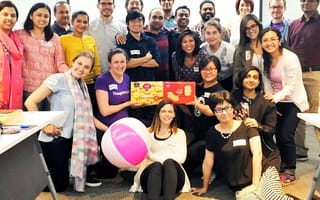
In the tech sector, there is an indisputable push to create a more diverse and inclusive space in what has traditionally been a homogenous industry. While many companies are eager to “talk the talk” when it comes to diversifying their workforce, a much more select few are just as eager to “walk the walk” in implementing large-scale changes.
ThoughtWorks, a global tech consulting firm, positions itself in the latter category with progressive core values that are flexed on a daily basis. Ensuring that this tangible culture thrives is Tarsha McCormick, ThoughtWorks’s North American head of diversity and inclusion. McCormick has grown with ThoughtWorks for nearly 20 years, and has spent the most recent three spearheading proactive, hyperlocal yet globally focused measures to further push ThoughtWorks’s reputation as a diversity hub.
“Actions are more powerful than words,” explained McCormick. “Active support by senior leaders and key stakeholders sends the right message.” She said the company maintains a presence at events like Lesbians Who Tech, and stays involved in the community through mentorship for programs like the Technovation Challenge.
A significant portion of this hands-on approach involves directly involving employees in the process of implementing change, and the celebration of recognizing diversity.
“We believe every employee can contribute and it’s the sum of all the individual activities that have impact,” McCormick said. “We have always had an open culture where we have encouraged our employees to share their thoughts, concerns and passions through informal and formal channels.”
We believe every employee can contribute and it’s the sum of all the individual activities that have impact."
There are two types of diversity initiatives at ThoughtWorks, McCormick said: Formal and informal.
“Formally,” McCormick continued, “Our Diversity and Inclusion Council allows employees to lead much of our work and initiatives in this space. Informally, we have employee led, grassroots resource groups that were created by our employees.”
It is this style of employer-sponsored, employee-lead initiative that ThoughtWorks believes drives real change. Creating a culture in which employees are as unafraid to rejoice in their diversity as they are to have potentially difficult, uncomfortable conversations with one another instills a deeper company culture, as opposed to ideas referenced in a quickly-forgotten employee handbook, McCormick said.
ThoughtWorks has also found success in broadening their definition of diversity and inclusion.
Often in the tech sector, diversity acts as shorthand for “non-male.” At ThoughtWorks, McCormick hopes to inspire her company to think across lines of gender, race and class to imagine a more comprehensive image of diversity.
Though ThoughtWorks is a truly global company, the New York City office has one of the most active and involved employee bases. McCormick explained that the collaborative floor plan actually inspired the team to open their doors to the larger community to host meetups and mingle the ThoughtWorks mission with the larger goals and interests of the local activist community.
McCormick explained that this NYC-based initiative was a runaway success, and has since become the norm throughout the company: “The concept of opening our office space to the larger community has since been adopted by our other offices. On any given day, we are hosting events or lending our space to tech and social impact groups across the globe.”
An upcoming event in NYC for example, “Progressive Hack Night,” will challenge coders to think about ways technology can help solve the opioid crisis. Other, more casual events include “Hot Chocolate, Hot Topics,” which invites women to swap stories about balancing work and life, mentorship and more.
While ThoughtWorks has truly tapped into something special with their multi-layered approach, they are by no means interested in keeping the secret sauce to themselves. As McCormick put it, “While there is not a ‘one size fits all’ approach to building a diverse and inclusive workforce, organizations tend to be more successful in this area when upper management is on board, diversity and inclusion goals are tied to the overall goals of the business, there are measures of success in place and you involve your employees.”
Above all, McCormick emphasizes a “bottom-up” strategy, a willingness to have difficult conversations and an ever-evolving outlook.
“While we have made strides to building a more diverse and inclusive workplace, we still have a lot of work to do,” said McCormick. “We are continuously working toward building an even more diverse and inclusive workplace.”




